City Introduction
Guangzhou (the capital of Guangdong Province, sub-provincial city, "Millennium Commercial Port")
Guangzhou is the capital of Guangdong Province, a national central city, a mega-city, and a headquarters for the Southern Theater Command. It is an international metropolis, an international business center, an international comprehensive transportation hub, a national comprehensive gateway city and a national historical and cultural city, which is located by the State Council. Since the Qin Dynasty, Guangzhou has always been a political, military, economic, cultural and scientific center in southern China. Since the 1930s, Guangzhou has become the main port of the Silk Road on the sea. During the Tang and Song dynasties, it became China's largest port and the Ming and Qing dynasties became China's only port of foreign trade.
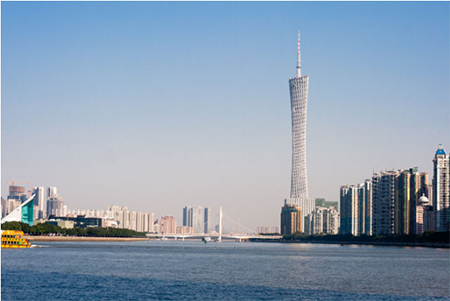
Guangzhou landmark waistline
Guangzhou is ranked as the world first-tier city by GaWC, the world's most authoritative world city research institute. Guangzhou headquarters economic development capability, the total stock of Grade A office occupies the first three. There are 30,000 foreign-funded enterprises in Guangzhou, 297 Fortune 500 companies, of which 120 have headquarters or regional headquarters in Guangzhou. More than 3,000 Internet companies in Guangzhou were born in WeChat, Vipshop, YY Voice, Cool Dog Music, Netease and UC Browser. The online game industry accounts for nearly 30% of the country's total revenue. Guangzhou Hard Science and Technology Development Index ranked the first three in the country; in 2016, high-tech enterprises ranked the second in the country in terms of increment, second only to Beijing.
Guangzhou's total retail sales of social consumer goods, total household deposits (resident savings deposits) and per capita household deposits rank the top three in the country; the per capita consumption ranks the first in the country; and the per capita disposable income ranks the first in the province. The UN report pointed out that the Guangzhou Human Development Index ranks first in China. The number of residents in Guangzhou City is the third largest in the country. Population growth in 2016 ranked the first in the country, attracting the largest number of college graduates across the province.
Guangzhou has 82 colleges and universities, with a total enrollment of 1.1396 million students, ranking the first in the country. Guangzhou has 97% of the national key disciplines, 70% of science and technology personnel and 95% of PhDs in the province; the number of key laboratories at all levels Ranking the first in the whole province; scientific and technological innovation won the national and provincial awards for science and technology accounting for more than half of the province; and built the largest clustering of technology business incubators in southern China.

Guangzhou University City
Location Habitat:
Guangzhou is located in southern China, central and southern Guangdong Province, the central and northern fringe of the Pearl River Delta, the junction of the Three Rivers of the Xijiang River, the Beijiang River and the Dongjiang River. It borders on the South China Sea to the east, borders Boluo and Longmen in the east, Sanshui, Nanhai and Shunde in the west By Qingyuan downtown and Fogang County and Xinfeng County, south of Dongguan City and Zhongshan City, across the sea and Hong Kong and Macao across the sea is one of the starting point of the Silk Road, China's "South Gate" is the city of Guangfo Circle, Guangdong-Hong Kong-Macau metropolitan circle, the core city of the Pearl River Delta metropolitan area.
Climatic conditions:
Guangzhou is located in the subtropical coast, the Tropic of Cancer from central and southern through, is a subtropical maritime monsoon climate, with warm and rainy, adequate light and heat, long summer, short frost period is characterized. The annual average temperature of 20-22 degrees Celsius, China's annual average temperature is one of the smallest cities. The hottest month of the year is July, with an average monthly temperature of 28.7 ℃. The coldest month is January, the monthly average temperature is 9 ~ 16 ℃. The average relative humidity of 77%, urban annual rainfall of about 1720 mm. Throughout the year, April to June is the rainy season. From July to September, the weather is hot and there are many typhoons. The temperatures are moderate in October, November and March, and cool in December and February. Throughout the year water and heat over the same period, abundant rainfall, conducive to plant growth, evergreen, flowers "flowers city."
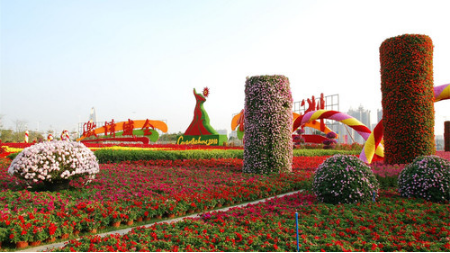
Guangzhou Flower City Square
topography:
Guangzhou belongs to the hilly region, the terrain northeast high, low in the southwest, back to the sea, the forest is concentrated in the northern hilly region, the highest peak for the north of Conghua City and Longmen County at the junction of heavenly top, elevation of 1210 meters; northeastern low mountains , There are known as "lung" Baiyun Mountain; central hilly basin, southern coastal alluvial plain, as part of the Pearl River Delta.
Administrative divisions:
Guangzhou covers a total area of 7434.4 square kilometers of cities, which are Yuexiu, Haizhu, Liwan, Tianhe, Baiyun, Huangpu and Nansha. Dongshan, Fangcun, Luogang was one of the old seven districts, after the withdrawal due to the merger, Nansha for the new part of the old seven districts. Old Fourth District refers to the original Yuexiu District, Dongshan District, Haizhu District, Liwan District, but after the adjustment of the region, the old Third District (Old Town), referring to Yuexiu, Liwan, Haizhu; New Fourth District Panyu District, Huadu District, Conghua District, Zengcheng District.
population:
At the end of 2016, the resident population of Guangzhou was 14,043,500, an increase of 542,400 from the end of 2015, ranking first in the country in terms of increment. The registered population is 8.74 million and the urban population is 86.06%.
Nationality:
In 2015, Guangzhou had a population of 718,000 ethnic minorities, belonging to 55 ethnic minorities. Among them, 88,000 are ethnic minority residents and 630,000 are non-resident ethnic minorities.
overseas Chinese:
At the end of 2015, there were nearly 4 million overseas Chinese and overseas Chinese, compatriots in Hong Kong and Maucao and returned overseas Chinese and overseas Chinese in Hong Kong and Macao. Among them, nearly four hundred million of the overseas Chinese returned overseas Chinese and the families of overseas Chinese in Hong Kong and Macao were close to 160 Million, accounting for nearly 1/5 of the census register population in Guangzhou, overseas Chinese and Hong Kong and Macao compatriots nearly 2.4 million people, distributed in more than 130 countries and regions in the world, mainly concentrated in Asia, North America, Oceania and Hong Kong and Maucao.
foreigner:
As a window of foreign trade, Guangzhou has a large number of expatriates. In 2013, there were 5.22 million foreigners entering and leaving Guangzhou from various ports in Guangzhou. As of October 25, 2014, the number of foreigners living in Guangzhou is 118,000, of which 57,000 are in Asia, 36,000 in Europe and the United States and 16,000 in Africa.
aviation:
Founded in the 1930s, Guangzhou Baiyun International Airport is one of China's three major international aviation hub airports and one of the national hub airports. It is also an important international aviation hub for the nation's "Belt and Road" strategy and the "Silk Road". Flight 4F level. Has become China's first gateway to Southeast Asia and Oceania. In 2016, the passenger throughput reached 59.73 million and the cargo and mail throughput reached 1.65 million tons. There were 149 international routes open to more than 200 countries and regions in Asia, Africa, Europe, North America and Oceania. Terminal 2 will be put into operation before the Spring Festival in 2018 and will meet the demand of using 80 million passengers per year, 2.5 million tons of cargo and mail and 620,000 aircraft movements. T3 terminal will be completed in 2022 and the fourth and fifth runways are under planning and construction. After the completion of Phase III of Baiyun Airport is expected to be completed, the airport throughput capacity will reach 105 million passengers / year and cargo and mail throughput will reach 5 million tons / year.
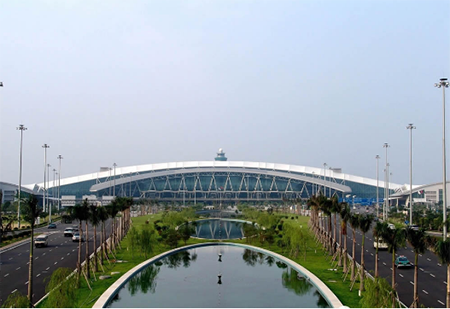
Guangzhou Baiyun Airport
Guangzhou Airport Comprehensive Free Trade Zone officially approved by the State Council, is China's largest airport comprehensive bonded zone.
subway
As of June 2017, Guangzhou Subway has a total of 10 operating routes (Line 1 to Line 8, Guangfo Line and APM Line) with a total length of 308.7 km and a total of 167 stations, opening third in mileage and third in the world Ten, daily average passenger traffic is expected to reach 7770000 passengers, passenger flow intensity first in the country. On April 30, 2017, the daily traffic volume reached 9.083 million, setting a new historical record.
Shipping
Guangzhou is one of 14 coastal port cities opened in 1984 and is the largest integrated hub in South China. In 2016, Guangzhou Port completed a cargo throughput of 544 million tons, an increase of 4.5% over the same period of last year, ranking first in South China, fourth in domestic coastal ports and sixth in global ports; completed container throughput of 18.86 million TEUs, up 7.0% .
Guangzhou Port has opened 87 international routes and 105 domestic trade routes. Maersk, CMA CGM, etc. The world's top 21 shipping giants all operate in Guangzhou Port and now trade with over 500 ports in over 170 countries and regions. Lotus Hill Port, Nansha Port, Guangzhou Development Zone Sui Port and Zengcheng Xintang Port have opened to and from Hong Kong passenger, freighter, Huadu District, opened to and from Hong Kong freighter. Guangzhou River and more than 100 river connected.
Traffic in the city:
● bus
Guangzhou bus downtown bus (including the night line), Guangzhou BRT, intercity bus, airport green, the University City Line (wide prefix, University City prefix), South China Building Pakistan, tourism, green peak line, Science City Line , Business lines, subway lines and other routes; of which Huadu District, Panyu District, Nansha three suburbs have their own bus system, the other Luogang K01, K02 for free bus.
● tram
Guangzhou Haizhu tram has been opened, Zengcheng tram pilot section of one or two lines in 2016 planned to open operations. Guangzhou University City tram planning 2017 Opened.
● trolley bus
Residents in Guangzhou City, often referred to as "tram", opened to traffic in 1960, is the only one in Guangdong Province has a trolley bus system in the city. A total of 14 lines.
● public bike
June 22, 2010 opened in Guangzhou public bicycle service.
● ferry
Dashatou pier, Pacific Tongjin, Pacific warehouse, Osaka warehouse terminal, dock and other Zhongshan.
● water bus
The first waterbus line in Guangzhou started its operation in 2007, with a string of four terminals, namely Fangcun Pier, Xidi Pier, Tianzi Pier and Zhongshan Pier.

Guangzhou water bus
economic:
Summary
In 2016, the GDP of Guangzhou was 1,961,094 million yuan, an increase of 8.2% over 2015. Regional GDP ranks third in mainland China. The three industrial structures are 1.22: 30.22: 68.56. The tertiary industry accounts for 68.56% of the GDP, ranking among the top three in China, contributing 77% of the economic growth. The total budget revenue of 517.4 billion. Guangzhou has formed 10 industrial clusters of 10 billion in transportation, including automobile, petrochemical industry, electronics, electricity and heat production and supply, electrical machinery and equipment manufacturing, wholesale and retail, finance, real estate, leasing and business services. Guangzhou is vigorously implementing the IAB program (a new generation of information technology, artificial intelligence, biomedicine), to create a number of billions of industrial clusters.
The headquarter of Guangzhou ranks third in economic development in China and ranks among the first level cities in the headquarters economy. Guangzhou has attracted investors in more than 130 countries and regions to invest and start business and maintain business with more than 220 countries and regions. As of the end of September 2017, a total of 30,000 foreign-invested enterprises settled in Guangzhou. 297 Fortune 500 companies have set up 921 projects in Guangzhou, of which 120 have headquarters or regional headquarters in Guangzhou. In 2016, "China Top 100 Internet Enterprises" list, a total of eight companies in Guangzhou list, the total ranked first in Guangdong. 2017 Fortune Global Forum will be held in Guangzhou.
Guangzhou was rated by the United Nations as the fastest growing megacity in the world. 2016, "City of Opportunities" in 2017, Guangzhou ranks first in China cities. Among the top 100 cities in China in 2016 and the new ranking cities in China, Guangzhou ranked the top three in the country. In 2017, Guangzhou ranked third among the top 100 cities in China for three consecutive years.
primary industry
In 2016, total urban agricultural income in Guangzhou reached 184.51 billion yuan, an increase of 0.5%. Urban agricultural output value of 130.06 billion yuan, an increase of 0.5%. There are 94 leading agricultural enterprises above municipal level, including 7 leading state-level enterprises, 24 leading provincial-level enterprises and 30 urban agricultural demonstration zones. Agricultural industrialization output value of 9.25 billion yuan, an increase of 0.5%; scale of agricultural industrialization reached 22.4%, an increase of 0.5 percentage points.
Secondary industry
Guangzhou is an important industrial base in China and a comprehensive industrial manufacturing center in South China. For years of development, Guangzhou has developed a large number of export-oriented enterprises with a complete range of industries, relatively developed light industries and heavy industries, comprehensive supporting capabilities, scientific and technological capabilities and strong product development capabilities Modern industrial system. Of the 40 industries in China, Guangzhou has 34. Guangzhou Industrial occupies an important position in the national economy of Guangzhou, and the industrial added value accounts for more than one third of Guangzhou's GDP. The industrial output of the three pillar industries of automobile manufacturing, electronic communications and petrochemical industry accounts for about one-third of Guangzhou's total industrial output value.
In 2016, the industrial added value of Guangzhou reached 536.940 billion yuan, an increase of 6.2% over the previous year. The added value of high-tech manufacturing industry above designated size reached 66.45 billion yuan, up 7.5%. The three pillar industries of automobile manufacturing, electronic product manufacturing and petrochemical manufacturing above designated size achieved a total industrial output value of 969.348 billion yuan, an increase of 7.6% The proportion of total industrial output above 49.57%. With more than 100 billion manufacturing clusters in Guangzhou, namely the automobile, petrochemicals, electronics, major equipment, bio-health, new materials and high-end manufacturing, Guangzhou is the leading industrial restructuring and upgrading in the PRD. In 2016, Guangzhou Automobile production reached 2.63 million units, ranking second in the country; the scale of Guangzhou's intelligent equipment and robot industry was nearly 50 billion yuan, and Guangzhou's robot production ranked second in the country.
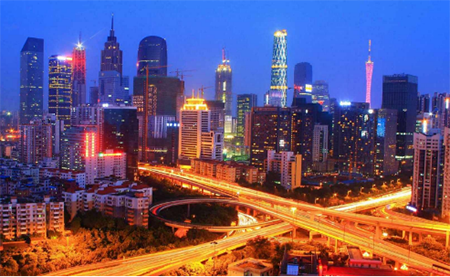
Guangzhou night scene
Tertiary Industry
● Business
Known as the "Millennium Port of Commerce," Guangzhou has historically been one of the most important commercial centers in China. With a large number of commercial outlets, a complete industry, and a wide range of radiations, the information flow and circulation channels are smooth. Guangzhou has more than 100,000 commercial outlets, ranking the top 10 cities in China. Beijing Road Commercial District, Jiangnan Avenue Commercial District, Renmin Road Commercial Street, the 10th Fu Commercial Pedestrian Street, Shangxiajiu Road Commercial District, Long Beach Commercial Area, Dongshankou Commercial Area, Tianhe Commercial Area, Zhujiang New Town, etc. for the larger city ring.
Guangzhou was rated as the best commercial city in mainland China by Forbes for five times. In 2016, total retail sales of social consumer goods in Guangzhou reached 870.649 billion yuan, ranking the third in China with the retail sales of consumer goods per capita ranking the first in China. The total import and export of goods reached 856.692 billion yuan, an increase of 3.1% over the previous year. Among them, the total amount of goods exported was 518.705 billion yuan; the total amount of commodity imports was 337.987 billion yuan.
● Finance
Guangzhou is the financial center in southern China and the capital city with the most financing ability in southern China. It is also the second batch of cities that China's foreign banks can open their access to. In 2011, Guangzhou became the third mainland city to join the "GDP trillions of clubs" following Shanghai and Beijing. Guangzhou is one of the first batch of 5 green finance reform and innovation pilot areas nationwide.
In 2016, Guangzhou achieved an added value of 180 billion yuan in financial services, an increase of 11% over the same period of last year and accounting for 9.2% of the city's GDP, making it the fifth pillar industry in the city. Guangzhou's financial industry to achieve direct financing accounted for the first in the country. The city's direct financing balance amounted to 1.35 trillion yuan, second only to Shanghai (1.49 trillion yuan) in major cities, accounting for 60.7% of the province (including Shenzhen). Guangzhou City, the proportion of direct financing of social financing accounted for 65.7%, ranking first in the country's major cities. In 2016, the city's premium income reached 116.62 billion yuan, ranking the third among big cities nationwide for 10 consecutive years; an increase of 64.2% over the same period of previous year, ranking first among major cities in China. Has three insurance institutions, 97 market players. In 2016, a total of 7 corporate financial institutions, 21 licensed financial institutions and over 1,000 financial institutions were listed, the highest in the calendar year. The balance of deposits in domestic and foreign currencies of financial institutions amounted to 4.753020 trillion yuan, with a deposit balance of 4.593734 trillion yuan and a loan balance of 2.966982 trillion yuan. As of the end of February 2017, the loan balance in Guangzhou surpassed 3 trillion yuan for the first time and the loan increment reached a historic high.
As of June 2017, there were 140 domestic and overseas listed companies in Guangzhou, an increase of 7 over last year with a total market capitalization of 2.2 trillion yuan; 412 new-board listed companies, 64 more than last year with a total market capitalization of 107.562 billion yuan The total fund-raising 92.82 billion yuan. 6789 listed companies in Guangzhou Equity Exchange Center, accumulative total amount of financing and circulation transactions amounted to 162.2453 billion yuan. In 2016, there were 10 new listed companies in the city with a total of 133 in total; 202 new and third board listed companies were added, a total of 348, with a growth rate of 84.4%, higher than that of the province (68.3%) and the whole country (41%), Ranked first in the country's major cities.
March 19, 2017, China Securities Quotation System South Operations Center officially settled in Guangzhou and started the CSI quotes Private equity market on-line ceremony The landing of the project, marking the two (Shanghai and Shenzhen Stock Exchange), the two systems System, China Securities Quotation System) in Beijing and Shanghai Guangsheng formed a four pillars of the situation. The two major financial brand projects are located in Guangzhou. The F20-International Financial Forum (IFF), hailed as the international financial community, has permanently settled in Guangzhou. China's top venture capital forum, the China Venture Capital Forum, is taking turns this year in Guangzhou and Shenzhen.
On June 27, 2017, seven ministries and commissions such as the People's Bank of China, the NDRC and the Ministry of Finance jointly issued the Overall Plan for Building a Green Finance Reform and Innovation Pilot Area in Guangzhou, Guangdong Province. The "Overall Plan" clearly states that Huadu District, Guangzhou City, take the lead in developing green finance reform and innovation pilot, with financial innovation to promote the strategic transformation of green leading industries to the main line, and strive within 5 years through the system, organization, market, products, services, security Measures and other areas of innovation and exploration, to achieve a rapid growth of green finance scale, the basic establishment of a green financial service system.
● Exhibition
As the earliest port in China for trade and commerce with foreign countries, Guangzhou has a long history and occupies a very important place in the world. The world-renowned China Import and Export Fair ("Canton Fair") has been held in Guangzhou since the 1950s and has won the title of "China's No. 1 Exhibition" with the largest scale, the longest time, the highest grade and the most volume. Pazhou International Convention and Exhibition Center, will "China's first exhibition" to a world-class level.

Guangzhou Pazhou Complex
In September 1993, the city of Montreal was held as a member city of the World Association of Metropolitan Cities and was elected as a member city in 1996. It was the earliest city to join and become a member of the board of directors in China. In 2000, it hosted the annual meeting of directors of the World Metropolitan Association And international seminars.
In 2012, Guangzhou successfully hosted large-scale cultural exchange activities such as the 2012 China (Guangzhou) Xinghai International Chorus Festival, the 17th Guangzhou International Art Fair and the 2012 China (Guangzhou) International Documentary Film Festival. In the international and Chinese professional literary awards, Guangzhou won a total of 34 awards.
Language:
Guangzhou is the core of Cantonese civil society, one of the cradles of Cantonese culture, Cantonese can be used throughout. The 1st World Cantonese People Assembly was held in Guangzhou in November 2013. [90] From the end of the Qing dynasty, photographs and maps made by foreigners and their maps and literature were marked with names and names in Cantonese pinyin. The KMT government defined the local standards as early as the Republic of China. The initial Pinyin scheme was imperfect and the rules were clear. Gradually improve the late, the program then spread to Hong Kong, Hong Kong government to become a Cantonese pinyin. After the founding of New China, Guangdong was banned, but was retained in Hong Kong, Macao and overseas.
Broad Cantonese dialect, also known as "Cantonese", "vernacular", is a Cantonese dialect Cantonese film, is the representative of Cantonese dialects, access to Guangzhou as the center of the Pearl River Delta, Guangdong and parts of northern Guangdong, and Guangxi southeast unit. Guangzhou dialect refers to the narrow Guangzhou dialect, specifically refers to the prevailing Cantonese in Guangzhou [91]. Hakka dialect is mainly distributed in Zengcheng District (nearly 40% of the local population). There are also Hakka ancient villages in Huadu District, Conghua District, Baiyun District, Tianhe District, Yuexiu District and Panyu District. Cantonese residents can basically speak Mandarin.
diet:
Guangzhou's food culture is famous in China. Is China's top ten food capital, the so-called "food in Guangzhou." Food Festival in Guangzhou every year, the food culture has a long history.
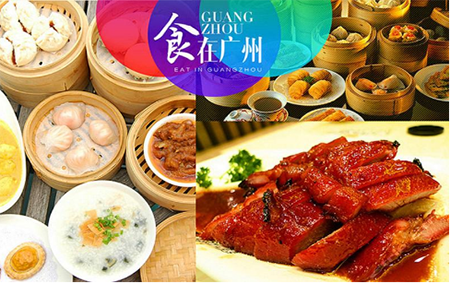
Food in Guangzhou
● Guangzhou cuisine
Guangzhou cuisine is based on the collection of outstanding folk cuisine in Guangdong Province on the basis of continuous absorption of the essence of the major Chinese cuisine, learn from the director of Western recipes, to integrate into one. Kwong House dishes widely used, fine selection of materials, excellent skill, good at changing, variety and variety. Canton cuisine is the main Cantonese cuisine and representatives. Taste to clear, fresh, tender, slippery, cool, fragrant, crisp-based, pay attention to not clear light, fresh and not vulgar, tender and not raw, the oil is not greasy. Seasonal, summer and autumn strive for light, strong emphasis on winter and spring [94]. Famous dishes are: white cut chicken, roast goose, roast suckling pig, braised pigeon, honey pork, lobster baked soup, steamed grouper, boiled shrimp, abalone, fried beef cattle and so on.
● morning tea
Guangzhou morning tea
Refreshments: "Cantonese tea can not forget to drink." Guangzhou people love to drink tea, especially love morning tea. In the morning, greetings from other places are mostly "eaten," while Cantonese are often "eaten tea?" (Did you drink tea?). Tea constitutes a distinctive trait of Lingnan culture distinguished from other cultures. Guangzhou people like to drink tea, such as morning tea, drink herbal tea, drink Kung Fu tea. Everybody likes to call friends in the holidays, to tea cafe. Tea is still followed, mainly to eat snacks, chatting. Wide variety of dim sum, beautifully made, each flavor. Name point, name snacks, famous food list.
● special snacks
Radish sirloin: radish sirloin is a famous traditional snack in Guangzhou, with white radish, fresh sirloin, accompanied by seasoning for a long time. In some bustling roads such as Beijing Road, Shangxiajiu Road and other places, the scent of radish sirloin filled the streets.
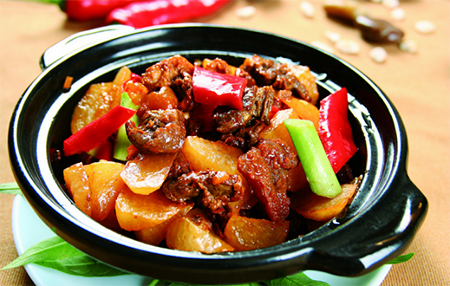
Radish sirloin
Wonton noodles: is the common name of wonton in Guangzhou, in Shangxiajiu Road, Xihua Road, People's Road area (ie, the West) are many such wonton noodles snack bar, is a famous snack in the West. As this product rich soup flavor, wonton skin thin stuffing, egg surface has a sense of play, which became Guangzhou people breakfast, a little gourmet. Wonton noodles also have a nickname small Rong.
And porridge: Ng Cham for the Republic of China during the famous small restaurant, located in Liwan Wenchang Lane, its most famous gruel and porridge, gruel at the end of dried ginkgo fish, porridge, bright white color, rice water blend, delicious flavor thick.
Boat Tsai porridge: Tsai Tsai porridge is a Guangdong congee, delicious.
Intestinal powder: a specialty snack in Guangzhou, Guangzhou snacks people eat, but also the size of the restaurant in Guangzhou, the restaurant morning tea market essential goods. Because of the shape of pig intestine, Guangzhou people also called pig intestines powder. It is said that during the Anti-Japanese War created by Pan Tong Huxian Museum, are small restaurants, restaurants, restaurants, hotels are available.

Steamed Vermicelli Roll
Lotus leaf package: also known as lotus leaf lotus leaf rice, is the famous flavor of Guangzhou snacks. It is made of lotus leaf wrapped rice and meat steamed. Lotus leaves green, rice balls loose, rice grain soft and cool and fresh, lotus leaf fragrance.
● restaurant old shop
The catering industry in Guangzhou is represented by "Four Gardens", namely East Garden Restaurant, South Garden Restaurant, West Garden Restaurant and North Garden Restaurant, supplemented by restaurants such as Guangzhou Restaurant, Panxi Restaurant, Lianxiang House and Tao Taoju Restaurant for a hundred years The old name of history.
● bar
Bar Street along the River Road, Bar Street, Central City Road, White Swan Bar Street and so on are more famous Bar Street in Guangzhou.

White Swan Lake Bar Street
tourism:
Guangzhou is rich in tourism resources, including Huacheng Square, Guangzhou Tower, Baiyun Mountain, Chimelong Tourist Resort, Pearl River Night Tour, Chen Clan Temple, Shawan Old Town, Shamian, Sacred Heart Cathedral, Lingnan Impression Park, Baomo Garden, Yuexiu Park, South Yue Wang Museum, Zhongshan Memorial Hall, Whampoa Military Academy, Nansha Wetland Park, Haizhu Lake National Wetland Park, Conghua Hot Springs attractions such as the most famous.
There are many cultural relics and historic sites in Guangzhou. As of 2010, 322 cultural relics protection units have been announced at the national, provincial and municipal levels. Among them, there are 24 state-level cultural relics protection units, 45 provincial-level cultural relics protection units and 253 municipal-level cultural relics protection units. South Vietnam tomb, Guangxiao Temple, Temple of Six Banyan Tree, Huaisheng Temple, etc. have more than 1,000 years of history. In addition, there are the South China Sea Temple was built in the Sui Dynasty, the Ming Five Immortals, Zhenhai Tower, Lotus Tower, the Qing Dynasty Chen Ancestral Hall, Yu Yin Shan room. The site of the revolutionary history of modern history was the site of the Peasant Movement Workshop sponsored by Comrade Mao Zedong, the cemetery of the Guangzhou Uprising Martyrs, the seventy-two Martyrs' Tomb of Huanghuagang, the Whampoa Military Academy, the Zhongshan Memorial Hall, and Hong Xiuquan's former residence. Guangzhou tradition Pollardus temple festivals, Guangfu temple festivals.
In 2016, Guangzhou received 59,405,600 overnight trips, an increase of 5.0% over the previous year. Among them, 8,187,700 inbound tourists, an increase of 7.3%; domestic tourists 50,786,900 passengers, an increase of 4.6%. Among the total number of inbound tourists, the number of foreigners was 3.3668 million, an increase of 7.0%; and the number of compatriots in Hong Kong, Macao and Taiwan was 533,900, an increase of 7.4%. The total tourism revenue was 3201.705 billion yuan, up by 12.0%. Tourism foreign exchange income 6.272 billion US dollars, an increase of 10.1%.

